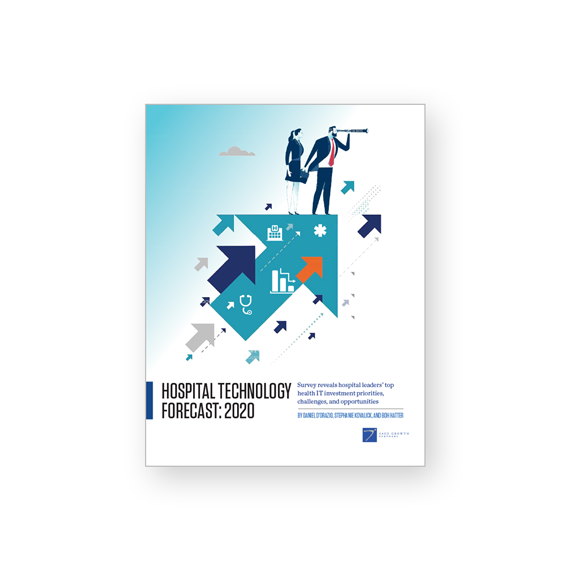A new survey of hospital C-suite leaders reveals 35% wish they had chosen a different EMR; more than half say they will seek out HIT solutions beyond the EMR for key needs
Baltimore, MD – March 3, 2020 – The past decade of healthcare delivery has been dominated by the electronic medical record (EMR), which has consumed vast hospital budgets and executive mindshare. However, 35 percent of hospital executives say if they could go back in time, they would choose a different EMR vendor, and 56 percent say they seek out other health IT vendors to fulfill their needs rather than wait for their EMR to provide a tool. These findings emerge in the Hospital Technology Forecast 2020, a new market report from Sage Growth Partners (SGP), a Baltimore-based healthcare research, strategy, and marketing firm.
Based on a survey of 100 hospital C-suite leaders conducted to gauge hospitals’ top health IT needs, challenges, and priorities, key findings include:
PESSIMISM ABOUT EMR CAPABILITIES ARE PERVASIVE; EMR LOYALTY IS WEAKENING
- More than a quarter (27 percent) of respondents believe their EMR will fail to meet their future needs. COOs are the most pessimistic (67 percent) followed by CEOs (37 percent), and CFOs (34 percent).
- If an organization’s EMR does not provide a tool they need, the majority (56 percent) of respondents say they seek out another vendor. Only 30 percent wait for the capability to be added to the EMR, and 14 percent say they create their own in-house solution.
- The top three reasons executives look outside the EMR for an IT solution are: patient safety is jeopardized (No. 1), an outside solution promises greater ROI (No. 2), and an outside solution promises greater quality (No. 3).
INVESTMENT OUTSIDE THE EMR IS ALREADY WIDESPREAD, ESPECIALLY IN NON-CLINICAL AREAS
- The top areas where hospitals have already invested in an IT solution outside of their EMR include data/analytics (73 percent), cybersecurity (70 percent), revenue cycle management (48 percent) and patient engagement (43 percent).
- Of the health IT segments that hospitals have invested in, the areas of greatest return on investment include revenue cycle management and data/analytics (tied at No. 1), cybersecurity (No. 2), and operational efficiency (No. 3).
- Over the next one to two years, hospitals’ top areas of health IT investment will include data/analytics (No. 1), operational efficiency (No. 2), patient engagement (No. 3), and revenue cycle (No. 4).
- When asked to select the top digital health priority for their organization, most respondents (36 percent) selected patient self-scheduling. Just over a quarter (28 percent) selected care coordination; fewer selected patient access to clinical and financial records (15 percent), remote patient monitoring (12 percent), or disease management (nine percent).
WITH LIMITED BUDGET AND ATTENTION, HOSPITAL LEADERS MAY CHOOSE THE PATH OF LEAST RESISTANCE
- Sixty percent of C-suite leaders said only up to three percent of net patient revenue will be budgeted for new IT investments. Only four percent of C-suite leaders said more than five percent of net revenue will go toward new IT investments.
- More than a quarter (28 percent) of survey respondents reported that vendors reach out to them daily, and another thirty percent field weekly inquiries.
- A quarter of survey respondents said their EMR vendor offers rebates and incentives for adopting tools within the EMR. Of those respondents, 70 percent said this increases the likelihood that they would choose the EMR solution over a best-of-breed solution outside the EMR.
BUT EXECUTIVES EXPECT ANY SOLUTION PROVIDER TO KEEP UP WITH INTEROPERABILITY REQUIREMENTS
- When asked how the recent CMS and ONC proposed rules on interoperability have affected IT investment plans, 48 percent said they simply expect their current vendors to provide solutions that meet the new rule requirements.
- About one in five (22 percent) plan to hold off on investment decisions until they know more about the new rules, and 16 percent plan to accelerate investment. Only 13 percent reported already being in compliance with the new rules.
“The movement for new, better, and more appropriate digital solutions is underway,” says Dan D’Orazio, SGP’s CEO. “This is driven by fatigue and frustration around EMRs, as well as the many striking studies that show poorly performing EMRs can negatively impact patient safety. While hospitals were willing to put up with poor workflows in the EMR, they aren’t willing to compromise on safety, quality, or ROI. Healthcare is about to enter a new decade of digital innovation, and we will continue to see IT vendors and outside players like Amazon, Walmart, and CVS, disrupt EMRs and traditional care models.”
###
Methodology
Sage Growth Partners surveyed 100 hospital C-suite executives in Q3 2019: chief information officers (25 percent), chief financial officers (21 percent), chief executive officers (19 percent), chief medical officers (18 percent), chief nursing officers (11 percent), and chief operating officers (six percent). Respondents were equally distributed across hospital size, with 35 percent from hospitals with 551+ staffed beds, 34 percent from hospitals with 251-500 staffed beds, and 31 percent from hospitals with less than 250 staffed beds.
About Sage Growth Partners
Sage Growth Partners accelerates commercial success for B2B, B2B2C, and B2C healthcare organizations through a singular focus on growth. The company helps its clients thrive amid the complexities of a rapidly changing marketplace with deep domain expertise and an integrated application of research, strategy, and marketing.
Founded in 2005, Sage Growth Partners is located in Baltimore, MD, and serves clients such as Philips Healthcare, Quest Diagnostics, Hughes and Company, Olive, It’s Never 2 Late, and Noro-Moseley Partners. Visit us online at www.sage-growth.com.






